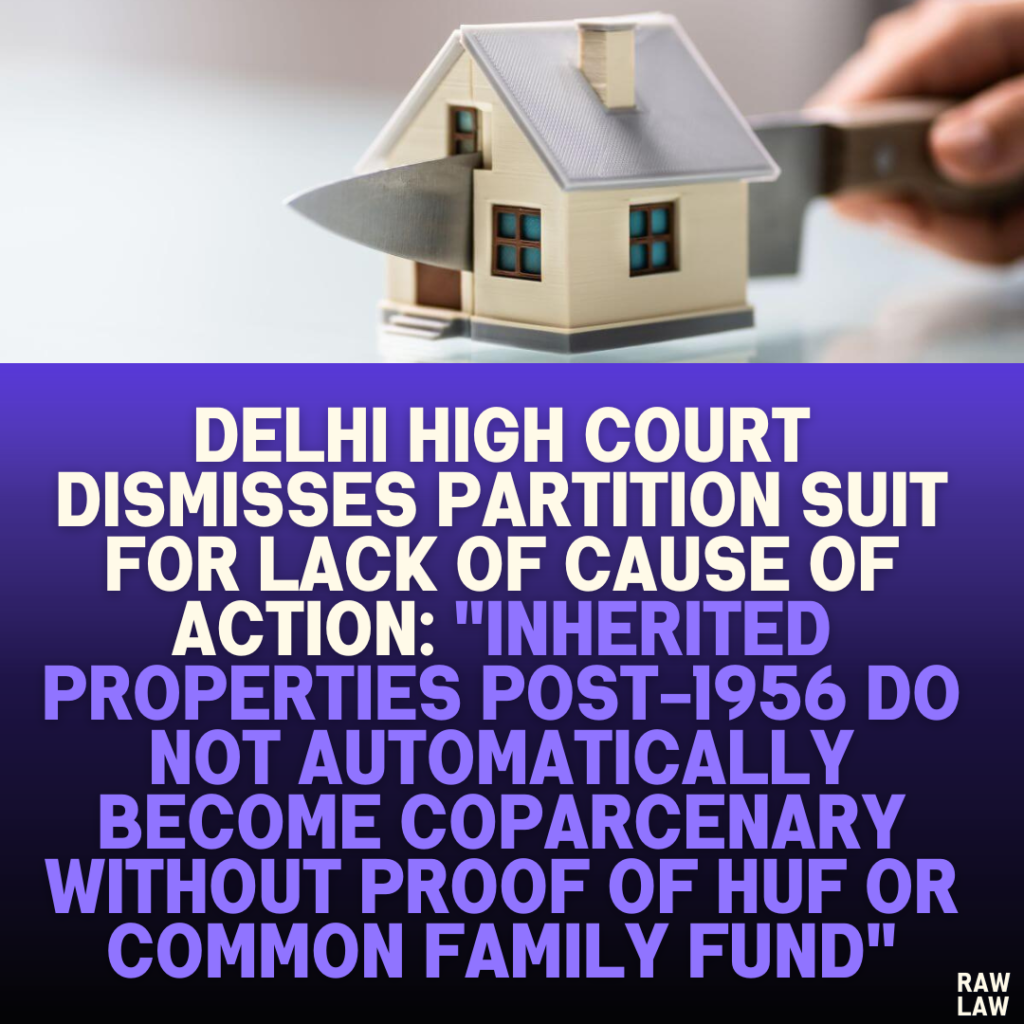Court’s Decision
The Delhi High Court rejected the plaint filed by the plaintiffs under Order VII Rule 11 of the Code of Civil Procedure (CPC) on the ground of non-disclosure of a valid cause of action. The Court held that:
- The plaintiffs failed to prove the existence of a Hindu Undivided Family (HUF) or coparcenary properties.
- Properties standing in the individual names of family members could not automatically be treated as coparcenary properties.
- The plaintiffs’ claim, based on Section 6 of the Hindu Succession Act, 1956, was misconceived.
Facts of the Case
- The plaintiffs, children of defendant no. 2, filed a suit seeking partition of nine immovable properties, alleging that these were coparcenary properties belonging to a HUF created by their grandfather, late Kewal Kishan Sachdeva.
- The plaintiffs argued that the funds for purchasing these properties came from their grandfather’s electrical goods business, thereby giving them coparcenary rights.
- The nine properties were titled individually:
- Some in the name of their grandfather,
- Some in the name of their father (defendant no. 2), and
- Some in the name of their uncle (defendant no. 3).
- The defendants argued that these properties were self-acquired and not coparcenary in nature. They also pointed out that no evidence was provided by the plaintiffs to substantiate their claim.
Issues Before the Court
- Whether the properties in question were coparcenary properties or individually owned self-acquired properties.
- Whether the plaintiffs could claim a share in the properties during the lifetime of their father and without proof of an existing HUF.
- Whether the plaint disclosed a valid cause of action under Hindu Succession Act, 1956.
Petitioner’s Arguments (Plaintiffs)
- The plaintiffs argued that under Hindu law, there is a presumption that a Hindu Undivided Family (HUF) exists, and therefore the defendants must prove that no such HUF exists.
- They alleged that the funds used to purchase the properties originated from the grandfather’s business, making these properties part of the HUF.
- They invoked Section 6 of the Hindu Succession Act, 1956, which gives coparcenary rights to children, including daughters, by birth.
- They claimed a share through their father’s (defendant no. 2’s) share in the properties.
Respondent’s Arguments (Defendants)
- The properties were self-acquired and titled individually. No legal presumption could be drawn that these were coparcenary properties.
- The plaint failed to comply with Order VI Rule 4 CPC, which mandates specific details when alleging the existence of an HUF or coparcenary properties.
- After the Hindu Succession Act, 1956, inherited properties do not automatically become coparcenary; they retain their character as individual/self-acquired properties.
- Income Tax records and title deeds showed that the properties were self-acquired, not HUF properties.
- Plaintiffs admitted they had no documents or evidence to prove the existence of an HUF or that the properties were purchased with a common family fund.
Analysis of the Law
- Hindu Succession Act, 1956:
- Under Section 8, properties inherited by a Hindu male after 1956 retain their individual character and do not automatically become part of a coparcenary.
- Only properties that were coparcenary before 1956 or properties blended into an existing coparcenary retain that character.
- Burden of Proof:
- The plaintiffs must provide specific material particulars (Order VI Rule 4 CPC) to establish the existence of an HUF or coparcenary properties.
- There is no presumption that all properties of a Hindu family are HUF properties.
- Doctrine of Blending:
- Individual properties can only become HUF properties if they are voluntarily blended with an existing coparcenary.
- In this case, the plaintiffs failed to prove any blending or existence of a pre-1956 coparcenary.
- Relevant Precedents:
- Surender Kumar v. Dhani Ram: Plaintiffs must plead material particulars to establish HUF existence.
- Yudhishter v. Ashok Kumar: Inherited properties retain their individual character under Section 8 of the Act.
- Neeraj Bhatia v. Ravinder Kumar Bhatia: Coparcenary is a creature of law and cannot be created by agreement or presumption.
Court’s Reasoning
- The plaintiffs failed to plead or prove the existence of an HUF. There was no evidence of a common family fund or nucleus.
- The properties were titled in the individual names of the grandfather, father, and uncle.
- The plaintiffs admitted they had no documents or tax records to show that these properties were part of an HUF.
- The Court emphasized that after 1956, inherited properties do not become coparcenary by default.
- Section 6 of the Hindu Succession Act applies only to coparcenary properties. Since the properties in question were self-acquired, the plaintiffs could not invoke this provision.
Conclusion
The Court held that:
- The plaint disclosed no cause of action under law, as the properties were self-acquired and not coparcenary.
- The plaintiffs’ claim was based on an illusory cause of action.
- The suit was dismissed under Order VII Rule 11 CPC.
Implications of the Judgment
- Proof of HUF: This judgment reiterates that the existence of an HUF cannot be presumed. Specific evidence and particulars must be provided.
- Post-1956 Properties: Inherited properties after 1956 retain their individual character and do not automatically become coparcenary.
- Burden of Proof: Plaintiffs seeking partition must establish the existence of coparcenary property beyond mere allegations.
- Doctrine of Blending: Individual properties cannot become HUF properties unless blended into an existing coparcenary.




Pingback: Himachal Pradesh High Court Denies Bail to Accused in 8.742 kg Charas Case: "Stringent NDPS Act Provisions and Societal Interest Outweigh Right to Liberty" - Raw Law